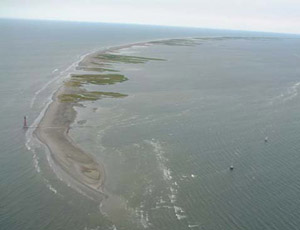A long-standing, but unfunded desire to restore Louisiana’s barrier islands may be fulfilled if British Petroleum agrees to foot the bill for a proposal to dredge and build up long-eroded islands to stop oil from encroaching on sensitive marshlands.

“Right now, it’s just talk, in the infant stages,” says Chris Accardo, chief of operations division for the New Orleans District, U.S. Army Corps of Engineers. The Corps would have to issue a permit for the project if the state, BP, and the U.S. Coast Guard decide to go forward with the plan.
The idea of beefing up the Timbalier and Chandeleur chains of barrier islands to protect against coastal erosion was “birthed several years ago as part of the Louisiana Coastal Restoration plan,” says Ancil Taylor, vice president of The Bean Companies, a New Orleans dredging company. “A week or so ago a Dutch delegation came in, took the restoration plan and suggested it be initiated immediately in an effort to be the first barrier to the marshes that lay behind.”
Taylor, who was contacted by representatives of Plaquemines Parish and the state to advise on constructability, says the concept quickly gained momentum as Bean identified available equipment throughout the Gulf Coast and along the eastern seaboard that could be mobilized quickly for the task.
The idea is to build a sand berm on the legacy footprint of the barrier islands (some lie beneath 2-7 ft. of water) up to elevation +6 ft. “It will be much easier to capture oil on those dunes than to chase it into the marshes,” Taylor says.
Proponents are suggesting initially attacking a 90-mile stretch to the east side of the Mississippi River and into the mouth, a feat that could be accomplished in four to six months with a dozen dredges, Taylor says. “Within 10 days, you would see the sand dune coming out of the water.”
If more equipment can be rallied, Taylor suspects a larger area—likely, moving further west—will be included in the build up, especially since oil flows are threatening a larger area than originally projected.
The suite of equipment that would be optimal for work on the east side of the mouth of the Mississippi River would be different than that required for work on the west side, Taylor explains. “On the east side of the river we have good material available within two to five miles of the barrier island footprint,” he says. “On the west side, we would have to go further away to get good material, so a different type of equipment would be used and material probably barged.”
Although Bean has never tackled a project this large, the process is “relatively simple,” Taylor says. He is confident that the dredging industry can build a barrier to block the oil flow in the most critical, identified areas. “I’m not an oil field expert, but I know how to move sand quickly and efficiently, and what types of equipment are most efficient to do that,” Taylor says.
It’s fortunate that the concept of restoring the barrier islands has been studied, and empirical data is available on appropriate material grain size, Taylor adds. “The limiting factor has been the funding.”
The Corps’ role would be “strictly regulatory,” says Accardo, who reiterates that the Corps can’t issue a permit until the scope of work is defined. Taylor outlined the proposal at a May 10 meeting. BP agreed to present the concept to the unified joint command for the Deepwater Horizon Response on May 11. Meanwhile, the Corps plans to present the concept to various environmental agencies, including the U.S. Fish and Wildlife Service; Department of Natural Resources; Environmental Protection Agency; and National Marine Fisheries.
“The ball is in the court of BP as to whether they want to fund it or not,” Accardo says. “We’re gathering the environmental agencies together so if BP does ask for a permit everyone will be aware of the concept.”
Neither the joint information command center in Robert, La., nor the State of Louisiana Office of Coastal Protection and Restoration responded to queries on this topic.

Post a comment to this article
Report Abusive Comment